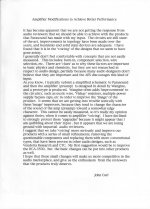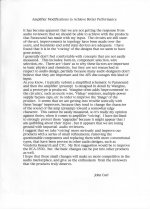Not much really, and some of Harry's strongest fans hate the mention. More like Colin Nancarrow or even Antille.
Cage was more an intellectual insider mixing the newly popular eastern/Zen ideas and music, and then there is 4'33".
I appriciate Cage but Harry was more "outsider" art.
Cage was regarded by many as more a philosopher than a composer. Partch was very very different, with his notion of a complete performance involving movement as well as music, and as far as I know not interested at all in aleatoric procedures and processes. And of course he was devoted to just intonation, hence the unique instruments (which drove him nuts keeping them in tune).
I never knew Harry (nor John, for that matter) although I knew people who worked with him. I've wondered if HP got to the point where intervals based on primes of 7 and higher actually sounded natural and normal. Seven for me is still something of a challenge 🙂
But I think just intonation is an important direction for music going forward, maybe not taken to the "11" or "13" limit of HP, at least not right away. So much is lost with equal temperament IMO.
I'm going to get shredded so bad for this;
It's just as much art as science.
Running away now. 🙂
It's just as much art as science.
Running away now. 🙂
Hi,
Usually, but not always, you see several capacitors in parallel...
Ciao T
> Too many caps in the power supply line
How can one tell there are too many ?
Usually, but not always, you see several capacitors in parallel...
Ciao T
Hi,
Technically speaking, Art is merely an intuitive, as opposed to intellectual grasp and approach to the same scientific problem (science being here used in the original sense of the latin word our modern usage is derived from).
Intuition can proceed where the intellect may fail because insufficient source data. Ideally a true scientist combines intuition and intellect so to speak a synthesis of thesis and antithesis...
Ciao T
It's just as much art as science.
Technically speaking, Art is merely an intuitive, as opposed to intellectual grasp and approach to the same scientific problem (science being here used in the original sense of the latin word our modern usage is derived from).
Intuition can proceed where the intellect may fail because insufficient source data. Ideally a true scientist combines intuition and intellect so to speak a synthesis of thesis and antithesis...
Ciao T
The headphone amp is still on the workbench. I have to get it into production. Thanks for reminding me.
John,
This is my first look at the HCA-3500, and there are some things I just don't get. First is, why first have an elaborate input stage, and then send the signal through 4 opamps? Couldn't serve U4A directly as a direct input buffer for unbalanced? With a line receiver for balanced? For directly coupled you can hang a servo somewhere in the line of opamps to ensure the optocoupler is loaded at its midpoint. I also don't see how non-linearities of the optocoupler and the outputstage get corrected. Probably missing something important.
vac
This is my first look at the HCA-3500, and there are some things I just don't get. First is, why first have an elaborate input stage, and then send the signal through 4 opamps? Couldn't serve U4A directly as a direct input buffer for unbalanced? With a line receiver for balanced? For directly coupled you can hang a servo somewhere in the line of opamps to ensure the optocoupler is loaded at its midpoint. I also don't see how non-linearities of the optocoupler and the outputstage get corrected. Probably missing something important.
vac
Vacuphile, NO IC op amps are used in the audio path. These are BIAS CONTROL or SERVO IC's. I would not DARE to use an IC in the direct path, after the problems I had with the HCA 2200 MK 1.
Last edited:
Did you design the sliding bias? It seems somehow uncharacteristic, but whadda I know?
Thanks,
Chris
Thanks,
Chris
Vacuphile, NO IC op amps are used in the audio path. These are BIAS CONTROL or SERVO IC's. I would not DARE to use an IC in the direct path, after the problems I had with the HCA 2200 MK 1.
I'll study some more, thanks.
It is NOT sliding bias, it is high-low bias, so that when idling with NO audio signal, it will not run as hot. We took it out of our better stuff.
John, I had another look but perhaps we are not looking at the same thing. It is about the schematic you posted in #22226.

The way I interpret it is that after the input stage with DC-servo U1 it connects on the drawing through -o 'out' into U4A..D to drive the power stage through optocoupler Q35. It must also be part of my general misunderstanding that I don't see why you directly couple the input, and then have two blocking caps C77 and C81 in the signal path.
vac

The way I interpret it is that after the input stage with DC-servo U1 it connects on the drawing through -o 'out' into U4A..D to drive the power stage through optocoupler Q35. It must also be part of my general misunderstanding that I don't see why you directly couple the input, and then have two blocking caps C77 and C81 in the signal path.
vac
Attachments
Last edited:
- Status
- Not open for further replies.
- Home
- Member Areas
- The Lounge
- John Curl's Blowtorch preamplifier part II

